2023 Toyota Prius & Prius Prime
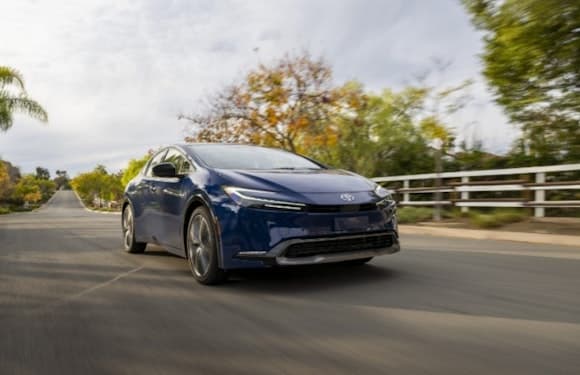
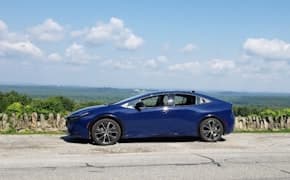
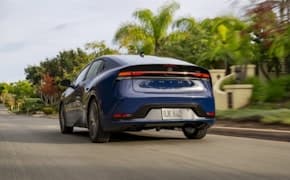
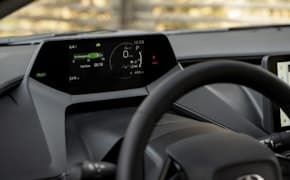
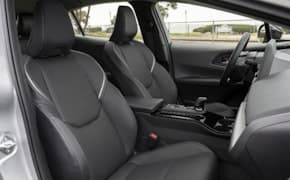
Show all photos
Summary
The Toyota Prius is all-new for 2023. It now offers a much more interesting design, widely considered to be one of the best-looking compact car styles sold. The powertrains are familiar but changed for the better across the board. The Prius Hybrid is front-wheel drive, and all-wheel drive is optional. The Prius Prime is the plug-in hybrid-electric version, and it is downright quick. The plug-in now offers around 40 miles of all-EV range, depending on the trim.
The Prius is now so efficient that it offers a lower cost per mile than battery-electric vehicles in many areas where electricity prices are higher than the national average. One added plus of the Prius Prime is that when it is fully charged and fully fueled it has a range of over 600 miles.
- Great personality
- Quick
- Enjoyable to drive
- Amazing fuel economy
- AWD and plug-in versions
- Excellent infotainment
- No spare tire in any trim
- Glass roof on some trims will make roof-top cargo options tricky
- Everything
Engine
Horsepower
MPG
Max Seating
Basic Warranty
Verdict - Is the 2023 Toyota Prius a Good Car?
The Toyota Prius is now one of the most satisfying to drive affordable cars on the market. We tested the front-wheel drive Limited trim and found it to be a joy on back-country roads, as well as a very nice highway cruiser. Around town in traffic, the Prius often operates in EV mode and is smooth and enjoyable as a daily driver.
The biggest change to the Prius for 2023 is its new powertrains. They offer sporty acceleration in all circumstances. The Prius is now quicker than a lot of very popular cars, trucks, crossovers, and SUVs. It also looks better than nearly all of them.
Of course, fuel economy and CO2 conservation are paramount considerations to many Prius shoppers. Here the Prius again leads the industry. The Prius trim with the best fuel economy offers 57 MPG Combined. The AWD trim with the largest wheels offers 49 MPG. The EPA has not yet finalized its Prius Prime data but we expect a rating of around 140 MPGe, better than most battery-electric vehicles in its class.
Beyond the facts and figures, the Prius has a great personality. The interior is an ideal mix of extremely high-quality tactile buttons paired with a perfect infotainment screen setup. A new novel driver information display mounted high above the top of your steering wheel negates the need for a projected head-up display.
The all-glass roof of our Limited trim test vehicle offered ample light and a sun shade for the front passengers as well as a separate one for rear seat passengers. Cargo space is plentiful and practical to use. Sadly, Toyota left out the spare tire.
Test Drive Notes
With over four decades of doling out trusted automotive advice and extensive vehicle knowledge, both behind the wheel and under the hood, Car Talk's founder and original Tappet Brother Ray Magliozzi shares his first-hand experience test driving the 2023 Toyota Prius.
Overall Car Talk Award
Car Talk researchers have tested this vehicle and decided to award it a 10 out of 10 based on our years of expertise and stringent criteria.
10/10
We have reviewed all of the following aspects of this vehicle.
10/10
10/10
10/10
Toyota Prius vs. The Competition
If you think we are going to limit the Prius’ competitors to other affordable hybrids, you are mistaken. This is a vehicle that transcends one segment.
Toyota Prius vs. Any Affordable Battery Electric Vehicle
Does your income place you among the majority of Americans who are not able to benefit from the federal income tax incentive on EVs? Or maybe you live in a city and don’t have a dedicated parking spot? Why not opt for a Prius or Prius Prime, live green, and do so at a cost lower than that of any affordable battery-electric vehicle? Which, by the way, will be one single model in 2024, the Nissan Leaf. There are no planned BEVs in the price range of the Prius for 2024. The LE and the LE AWD both have sticker prices, including the destination charge, under $30K. The Prius is the solution to high EV prices and charging hassles for those that want to drive green affordably.
Toyota Prius vs. Subaru Impreza / Crosstrek
Just prior to our test of the Prius, we tested the Subaru Impreza Sport RS and the Subaru Crosstrek Sport. We loved both for their utility, fun personalities, and price points. The Prius could not be more similar to this pairing of a hatchback and crossover. Size-wise, they are nearly identical. In terms of driving enjoyment, the Prius tops them both. And, since the Prius is offered in AWD, the matchup here is not out of line.
Toyota Prius vs. Mazda3
The Mazda3 is widely considered one of the very best small cars still sold in America. The hatchback is nearly identical in size to the Prius. Performance-wise, the Prius is a little quicker than the base Mazda3, and the Mazda3 Turbo is a bit quicker than the Prius Prime. We are splitting hairs here; all of these combinations are fun to drive and feel sporty. The Prius has a much better infotainment setup than the Mazda3, and the Mazda3 Turbo has a slight edge in terms of driving pleasure. The prices align very closely.
Toyota Prius vs. Tesla Model 3
During our testing, more than one passerby asked us if the Prius was a Tesla. Look at a Prius from the front ¾ angle, and it definitely looks sort of Tesla-ish. We are annoyed that much of the EVangelist media constantly portrays the Tesla Model 3 as an affordable EV when for those that don’t qualify for the federal tax incentive, it certainly is not. These two cars are both green, and the Model 3’s base trim performance is not that far off of what the Prius line now offers. Many older generation Prius owners have moved over to Tesla. Don’t be surprised if some of them end up with one of each in their garage. In areas where electricity is priced above the national average, a total cost of ownership comparison of the Prius and base Model 3 is not going to end up with the Model 3 as the winner.
How Much Does a 2023 Toyota Prius Cost?
The Prius line starts with the $28,545 base front-drive Prius LE. The LE AWD starts a few bucks under $30K. Throw all three option packages at an AWD Limited Prius, and you cannot break $40K. Our Limited FWD tester with all the option packages has a sticker price of $37,494.
The plug-in hybrid Prius Prime starts at $33,445. The very top trim with all of the packages, including the solar roof, prices out at $41,225. All of the prices we mentioned include the $1,095 Destination charge.
Toyota has designed out almost all of the maintenance needs typical of older conventional vehicles. Regenerative braking means that brake pads and rotors last much longer than in typical cars. There is also no starter or alternator to need repairing later. Pair the Prius’s remarkably low cost for energy with its two years of included maintenance, and it is possibly the lowest-cost-to-operate vehicle sold in America.
Performance - How Does the 2023 Toyota Prius Drive?
Let’s start with how the Prius feels before you drive off. The seats are full-size, and those six feet tall and 200 pounds can fit comfortably in the front or the back. Like many cars, the Prius has a low roofline and limited glass area in comparison to taller crossovers and SUVs. However, the Prius has decent visibility, and for 2023 it improves now that the split rear window is gone and replaced with a more conventional rear hatch plus an optional rear-view camera mirror.
The entire dash is a huge step forward in the new Prius. The touch-screen infotainment system is right-sized, quick to start, and Android Auto and Apple CarPlay are wireless. We didn’t experience any glitches at all during our testing.
The gear shifter feels substantial and is easy to become familiar with. By day three, we were using it intuitively without looking down. The drive mode and parking brake buttons are located in areas that make sense.
Heading off, the Prius will prefer to glide up to speed silently using only its electric motors. Toyota’s throttle is designed to keep you green. However, you can adapt and give the Prius plenty of power. Do so, and the Prius feels quick, and it is actually quicker than a very long list of popular vehicles. When you need or want passing power, the Prius has plenty to offer. Sport Mode wakes the Prius up and makes it more fun and better on hilly terrain.
We like the suspension of the Prius very much. It feels soft over small indentations in the road, even with its larger low-profile 19-inch wheels. Bigger bumps are handled in a way that feels solid, and we had no rattles or shakes in our tester with about 4,000 miles on the odometer.
Handling is not sports-car tight, but the Prius is fun to steer and turn. That applies to normal driving and spirited driving. If you want a vehicle to toss around at this price and size, the Mazda3 hatchback may be your better choice, but it will cost you tens of thousands more in fuel and maintenance over its lifespan for a similar ownership experience.
Due to a new technology Toyota has only just introduced, the Prius behaves in a novel way in light daily traffic. Called Proactive Driving Assist, the system uses sensors to track your surroundings and will help you manage distance control between your vehicle and a preceding vehicle, pedestrian, or bicyclist. The system uses regen and friction braking in combination. The regen is not firm at first, then increases as you continue to slow, and then eases off if the vehicle ahead resumes its higher speed. It’s hard to explain, but you won’t be annoyed by it. Rather, we loved it. It’s dramatically better than one-pedal EV driving. Steering is part of the system, but we didn’t feel much in the way of steering assist. The most noticeable sensation is the vehicle’s active slowing. Do not confuse this with the abrupt autonomous braking all new vehicles now have. It is not like that at all.
The new Prius drives quite well on the highway. We found it to be smooth. On backcountry and mountain roads, we had fun driving the Prius. It’s great to be behind the wheel of the Prius. The old Prius stereotypes (slow, boring) were mostly exaggerated, but they are now meaningless. The 2023 Prius is quicker and more nimble than most mainstream vehicles today. The Prius Prime has a 0-60 time quicker than a 2020 Honda Civic Si, 2004 Miata Turbo, and it is a lot quicker than old V8-powered muscle cars like the 1967 Camaro RS/SS 350 or the 1970 Corvette Stingray 454.
Despite using the AC most of the time, and despite a lot of jack-rabbit starts in Sport Mode, during our week with the Prius Limited (Hybrid), we observed 55.1 MPG. That is 3 MPG higher than its EPA rating. All Prius cars use Regular fuel.
Safety - How Safe is the Toyota Prius?
Neither IHHS nor NHTSA have had a chance to test and rate the new 2023 Prius. We would be shocked if it doesn’t at least earn a Top Safety Pick rating, but check the status of its safety testing before you buy. The list of active safety systems in the Prius is a mile long, and Toyota has prioritized safety in its recent redesigns.
Reliability & Quality - Is the Toyota Prius Reliable?
According to Consumer Reports, the Toyota Prius has proven to be one of the most reliable cars ever created by man. We checked in with an editor at Consumer Reports to ask if what we were seeing was correct, and he confirmed that almost no vehicle ever produced has had as many 5/5 reliability rating years as the Prius.
In its 2023 Durability Study, J.D. Power ranked Toyota near the very top of brands. Contrast this with Tesla, which scored lowest overall.
Features - What Toyota Prius Options Are Worth It?
If you live in an area where winter can produce snow and ice, the AWD option has some obvious appeal. Toyota’s AWD system works great, and the Prius still gets about 50 MPG with it. If you own a home with a garage or a place you can reliably charge, the plug-in hybrid option (Prius Prime) is worthy of consideration. With around 40 miles of electric range, the Prime can be an EV for many during their typical work week and will never need charging on road trips.
If you plan to mount things like skis, bikes, and kayaks to your roof, you may want to avoid the glass roof. You can do so by ordering an LE or XLE instead of the Limited in the Prius Hybrid, or in the Prius Prime line, you can opt for an SE or XSE. The Prime has an optional solar charging roof available. That is an option we would seriously consider if we lived in a sunny, dry area.
We tested the Hybrid Limited and found the larger 12.3” infotainment screen to be a great feature. We also loved the cooled seats.
Exterior colors
Supersonic Red
Cutting Edge
Guardian Gray
Reservoir Blue
Midnight Black Metallic
Wind Chill Pearl
Interior colors
Gradient Black, cloth
Light Gray, cloth
Warranty - What is the Toyota Prius Warranty?
Toyota’s warranty is among the shortest in the industry. However, the Prius Hybrid and Prius Prime PHEV both have an added warranty duration on the hybrid and electric parts of the powertrain. Given Toyota’s legendary reliability, we would not sweat the warranty and we would not recommend an extended warranty for a Prius. Toyota includes two years of maintenance in its purchase price.
- Basic: 3 years / 36k miles
- Powertrain: 5 years / 60k miles
- Hybrid system: 96 months / 100,000 miles
- Hybrid Battery Warranty of 120 months / 150,000 miles applies to CA Emission states: CA, CT, ME, MD, MA, NJ, NY, OR, RI, and VT
 Toyota Prius | |||
| Basic | 3 yr./ 36,000 mi. | 3 yr./ 36,000 mi. | 3 yr./ 36,000 mi. |
| Powertrain | 5 yr./ 60,000 mi. | 5 yr./ 60,000 mi. | - |
| Corrosion | 5 yr./ unlimited mi. | 5 yr./ unlimited mi. | 6 yr./ 100,000 mi. |
New or Used - Is a Toyota Prius Worth Buying Used?
Yes, a Toyota Prius is definitely worth buying used. Used Prius cars are in high demand and hold their value extremely well. We would suggest that shoppers consider Prius cars ten years old or newer. Some years, including 2010 back to 2006, had some potential problems shoppers should be aware of. Car Talk did a spotlight on the used Prius you can view here. Now that we have given a used Prius two thumbs up, let us warn you that the review we did here is for an entirely new generation. Read up on the older Prius and drive one before you buy. The older Prius, particularly prior to 2015, had many unusual features, and it was not everyone’s cup of tea.



